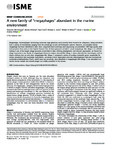A new family of “megaphages” abundant in the marine environment
| dc.contributor.author | Michniewski, S | |
| dc.contributor.author | Rihtman, B | |
| dc.contributor.author | Cook, R | |
| dc.contributor.author | Jones, MA | |
| dc.contributor.author | Wilson, WH | |
| dc.contributor.author | Scanlan, DJ | |
| dc.contributor.author | Millard, A | |
| dc.date.accessioned | 2022-03-07T11:08:56Z | |
| dc.date.available | 2022-03-07T11:08:56Z | |
| dc.date.issued | 2021-10-20 | |
| dc.identifier.issn | 2730-6151 | |
| dc.identifier.issn | 2730-6151 | |
| dc.identifier.other | 58 | |
| dc.identifier.uri | http://hdl.handle.net/10026.1/18896 | |
| dc.description.abstract |
<jats:title>Abstract</jats:title><jats:p>Megaphages, bacteriophages harbouring extremely large genomes, have recently been found to be ubiquitous, being described from a variety of microbiomes ranging from the animal gut to soil and freshwater systems. However, no complete marine megaphage has been identified to date. Here, using both short and long read sequencing, we assembled >900 high-quality draft viral genomes from water in the English Channel. One of these genomes included a novel megaphage, Mar_Mega_1 at >650 Kb, making it one of the largest phage genomes assembled to date. Utilising phylogenetic and network approaches, we found this phage represents a new family of megaphages. Genomic analysis showed Mar_Mega_1 shares relatively few homologues with its closest relatives, but, as with other megaphages Mar_Mega_1 contained a variety of auxiliary metabolic genes responsible for carbon metabolism and nucleotide biosynthesis, including a NADP-dependent isocitrate dehydrogenase [Idh] and nicotinamide-nucleotide amidohydrolase [PncC], which have not previously been identified in megaphages. Mar_Mega_1 was abundant in a marine virome sample and related phages are widely prevalent in the oceans.</jats:p> | |
| dc.format.extent | 58- | |
| dc.language | en | |
| dc.language.iso | en | |
| dc.publisher | Springer Science and Business Media LLC | |
| dc.subject | Genetics | |
| dc.subject | Human Genome | |
| dc.subject | 2.1 Biological and endogenous factors | |
| dc.title | A new family of “megaphages” abundant in the marine environment | |
| dc.type | journal-article | |
| plymouth.issue | 1 | |
| plymouth.volume | 1 | |
| plymouth.publication-status | Published online | |
| plymouth.journal | ISME Communications | |
| dc.identifier.doi | 10.1038/s43705-021-00064-6 | |
| plymouth.organisational-group | /Plymouth | |
| plymouth.organisational-group | /Plymouth/Faculty of Science and Engineering | |
| plymouth.organisational-group | /Plymouth/Faculty of Science and Engineering/School of Biological and Marine Sciences | |
| plymouth.organisational-group | /Plymouth/REF 2021 Researchers by UoA | |
| plymouth.organisational-group | /Plymouth/REF 2021 Researchers by UoA/UoA07 Earth Systems and Environmental Sciences | |
| plymouth.organisational-group | /Plymouth/Users by role | |
| plymouth.organisational-group | /Plymouth/Users by role/Academics | |
| dcterms.dateAccepted | 2021-10-01 | |
| dc.rights.embargodate | 2022-3-8 | |
| dc.identifier.eissn | 2730-6151 | |
| dc.rights.embargoperiod | Not known | |
| rioxxterms.versionofrecord | 10.1038/s43705-021-00064-6 | |
| rioxxterms.licenseref.uri | http://www.rioxx.net/licenses/all-rights-reserved | |
| rioxxterms.licenseref.startdate | 2021-10-20 | |
| rioxxterms.type | Journal Article/Review |


